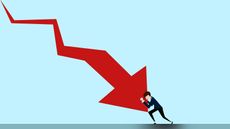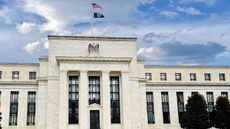The Era of Super-Low Interest Rates Could Be Over: The Kiplinger Letter
We’re likely never going back to the super-low interest rates that prevailed in late 2019 and early 2020.

To help you understand what is going on in the financial sector and what we expect to happen in the future, our highly experienced Kiplinger Letter team will keep you abreast of the latest developments and forecasts (Get a free issue of The Kiplinger Letter or subscribe). You'll get all the latest news first by subscribing, but we will publish many (but not all) of the forecasts a few days afterward online. Here’s the latest…
Now that the Federal Reserve has increased its rate by more than five percentage points and bond yields have recently climbed steeply, we hear a lot of talk about when interest rates are going to go back down “to normal.” Our view: They aren’t. This is a return to normal after 15 years of short-term rates near 0%.
The Fed may be about done hiking rates. But it won’t be slashing them again, the way it did repeatedly in the past two decades when recessions or financial crises hit. Markets have grown conditioned to nearly cost-free money whenever the economy gets into trouble. We think the Fed can no longer oblige. Lingering inflation, still smoldering now, could flare up again quickly if the Fed resorted to its recent instinct to cut deeply.

Sign up for Kiplinger’s Free E-Newsletters
Profit and prosper with the best of expert advice on investing, taxes, retirement, personal finance and more - straight to your e-mail.
Profit and prosper with the best of expert advice - straight to your e-mail.
Ditto for bond yields. Higher for longer is our outlook. While we don’t expect a repetition of the early 1980s, when yields shot above 10 percent, they’ll stay elevated for the foreseeable future. The benchmark 10-year Treasury, now yielding 4.9 percent, could eclipse 5% in the near term. It may slip a bit next year. But we won’t return to yields starting with a one or a two. Think 4% or more.
Note the many economic implications of this basic shift in financing costs:
- Savers can finally earn a decent return on cash, money market funds, etc.
- By extension, investors will feel less pressure to buy stocks. The old cliché that “there’s no alternative” to stocks no longer applies when cash earns 5 percent or more with no risk. So, there will be less pressure to buy stocks, especially speculative ones.
- Pension funds will be in better financial shape now that the available yields on safe instruments like Treasuries are so much higher than they’ve been in years.
- Annuities will offer better terms to compete with respectable interest rates.
Of course, higher rates hurt borrowers of all types. Homebuyers, especially. Today’s mortgage rates aren’t high by historical standards, but they are the highest in two decades. That, plus high prices, are leading many would-be buyers to give up.
Higher mortgage rates figure to keep a tight lid on home sales: 60% of folks with a mortgage locked into a rate below 4% in recent years. Many of them won’t want to sell their home and pay 7% on a new loan. Thus, a continuing dearth of listings.
Then there’s the biggest borrower of all — Washington. Higher bond yields make the Treasury’s mounting debt even more daunting. Just financing the debt is going to cost about $800 billion this fiscal year. Later this decade, over $1 trillion. Uncle Sam’s red ink will put the Fed in a bind. Does it cut interest rates to keep government financing costs bearable, and risk worse inflation in the future? It’ll resist calls to do so, but with no end to huge deficits in sight, the Fed may crack.
This forecast first appeared in The Kiplinger Letter, which has been running since 1923 and is a collection of concise weekly forecasts on business and economic trends, as well as what to expect from Washington, to help you understand what’s coming up to make the most of your investments and your money. Subscribe to The Kiplinger Letter.
Related Content

David is both staff economist and reporter for The Kiplinger Letter, overseeing Kiplinger forecasts for the U.S. and world economies. Previously, he was senior principal economist in the Center for Forecasting and Modeling at IHS/GlobalInsight, and an economist in the Chief Economist's Office of the U.S. Department of Commerce. David has co-written weekly reports on economic conditions since 1992, and has forecasted GDP and its components since 1995, beating the Blue Chip Indicators forecasts two-thirds of the time. David is a Certified Business Economist as recognized by the National Association for Business Economics. He has two master's degrees and is ABD in economics from the University of North Carolina at Chapel Hill.
-
-
 The Simple Yet Devastatingly Effective Secret To Warren Buffett and Oprah's Success
The Simple Yet Devastatingly Effective Secret To Warren Buffett and Oprah's SuccessA look at the common lesson to learn from the success of Warren Buffett and Oprah Winfrey.
By Eric McLoyd Published
-
 Putting Catch-Up Contributions Into a Roth 401(k) Isn't a Bad Idea
Putting Catch-Up Contributions Into a Roth 401(k) Isn't a Bad IdeaRoth 401(k) High earners will be required to put their catch-up contributions in a Roth 401(k).
By Sandra Block Published
-
 Rental Market Will Slow Through 2023: The Kiplinger Letter
Rental Market Will Slow Through 2023: The Kiplinger LetterThe Kiplinger Letter Expected growth in the rental market is likely to remain slow for the rest of the year amid a slow housing market and cooling economy.
By Rodrigo Sermeño Published
-
 Passport Processing Times Speed Up: The Kiplinger Letter
Passport Processing Times Speed Up: The Kiplinger LetterThe Kiplinger Letter The State Department credits an increase in staff and new technology with shrinking processing times.
By Sean Lengell Published
-
 SEC Cracks Down on Misleading Fund Names: The Kiplinger Letter
SEC Cracks Down on Misleading Fund Names: The Kiplinger LetterThe Kiplinger Letter The SEC rules aim to crack down on so-called “greenwashing” — misleading or deceptive claims by funds that use ESG factors.
By Rodrigo Sermeño Published
-
 As Tensions Rise, U.S. Imports From China Shrink: The Kiplinger Letter
As Tensions Rise, U.S. Imports From China Shrink: The Kiplinger LetterThe Kiplinger Letter China now accounts for less than 13.5% of American imports from abroad.
By Rodrigo Sermeño Published
-
 15 Cancer Drugs Are in Short Supply, FDA reports: The Kiplinger Letter
15 Cancer Drugs Are in Short Supply, FDA reports: The Kiplinger LetterThe Kiplinger Letter The U.S. is working to address cancer drug shortages caused by manufacturing and supply chain woes.
By Matthew Housiaux Published
-
 Media Industry Faces Shake-up as Competition Increases: The Letter
Media Industry Faces Shake-up as Competition Increases: The LetterThe Kiplinger Letter Changes in technology, weak advertising and streaming wars that have created disruption and uncertainty.
By John Miley Published
-
 Is the Economy Inching Toward a Recession?: The Kiplinger Letter
Is the Economy Inching Toward a Recession?: The Kiplinger LetterThe Kiplinger Letter The odds of the U.S. tipping into a recession could depend on how a few key issues are resolved in the coming months.
By David Payne Published
-
 The Fed Holds Interest Rates Steady
The Fed Holds Interest Rates SteadyThe Fed cautions that inflation remains high and it is prepared to adjust its monetary policy ‘as appropriate if risks emerge.’
By Esther D’Amico Published









